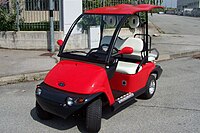
Back Elektrofahrzeug ALS مركبة كهربائية Arabic Електрическо превозно средство Bulgarian বৈদ্যুতিক যানবাহন Bengali/Bangla Vehicle elèctric Catalan ئامرازەکانی گواستنەوەی کارەبایی CKB Elkøretøj Danish Elektrofahrzeug German Ηλεκτροκίνητο όχημα Greek Elektra veturilo Esperanto
- Electric car, a BMW i3 charging from a standard electrical outlet.
- Electric aircraft, the Solar Impulse 2, which circumnavigated the globe
- Electric boat, the Tûranor PlanetSolar, the first solar-powered boat to circumnavigate the world
- Electric high speed train, N700 Series Shinkansen of JR Central on the San'yo Shinkansen, Japan
- Battery electric bus, a BYD bus in Landskrona, Sweden
- E-bike, a Geero, with the removable battery integrated into the down tube.
- Electric truck, Class 8, a Tesla Semi in Rocklin, California
- Electric cart, an Italcar Attiva C2S.4
An electric vehicle (EV) is a vehicle whose propulsion is powered fully or mostly by electricity.[1] EVs include road and rail vehicles, electric boats and underwater vessels, electric aircraft and electric spacecraft.
Early electric vehicles first came into existence in the late 19th century, when the Second Industrial Revolution brought forth electrification and mass utilization of DC and AC electric motors. Using electricity was among the preferred methods for motor vehicle propulsion as it provides a level of quietness, comfort and ease of operation that could not be achieved by the gasoline engine cars of the time, but range anxiety due to the limited energy storage offered by contemporary battery technologies hindered any mass adoption of private electric vehicles throughout the 20th century. Internal combustion engines (both gasoline and diesel engines) were the dominant propulsion mechanisms for cars and trucks for about 100 years, but electricity-powered locomotion remained commonplace in other vehicle types, such as overhead line-powered mass transit vehicles like electric trains, trams, monorails and trolley buses, as well as various small, low-speed, short-range battery-powered personal vehicles such as mobility scooters.
Hybrid electric vehicles, where electric motors are used as a supplementary propulsion to internal combustion engines, became more widespread in the late 1990s. Plug-in hybrid electric vehicles, where electric motors can be used as the predominant propulsion rather than a supplement, did not see any mass production until the late 2000s, and battery electric cars did not become practical options for the consumer market until the 2010s.
Progress in batteries, electric motors and power electronics have made electric cars more feasible than during the 20th century. As a means of reducing tailpipe emissions of carbon dioxide and other pollutants, and to reduce use of fossil fuels, government incentives are available in many areas to promote the adoption of electric cars and trucks.[2]
- ^ "Glossary — Global Warming of 1.5 ºC". Retrieved 4 September 2024.
- ^ Pamidimukkala, Apurva; Kermanshachi, Sharareh; Rosenberger, Jay Michael; Hladik, Greg (2023). "Adoption of electric vehicles: A state-of-art review". Transportation Research Procedia. 73: 313–320. doi:10.1016/j.trpro.2023.11.923.








